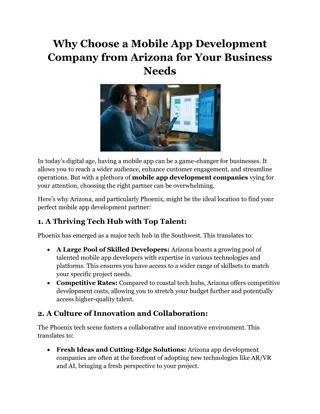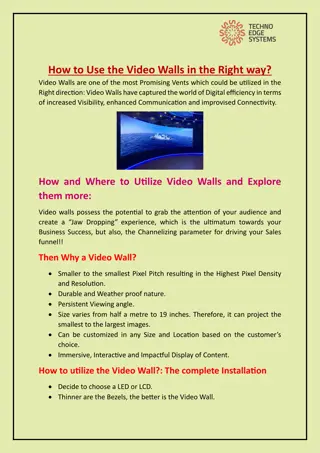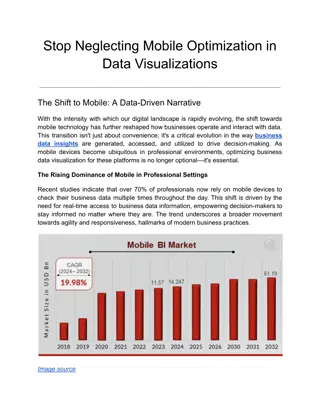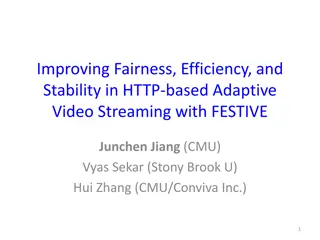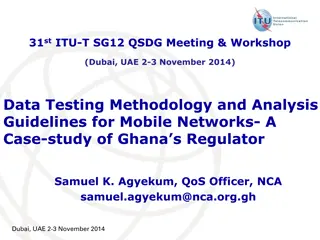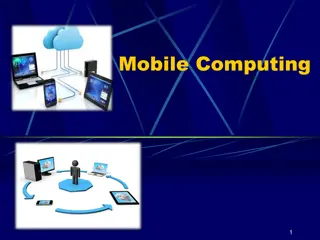Measurement Study of Mobile Video Calls: Can You SEE Me Now?
Users increasingly prefer mobile video calls over desktop setups. This study delves into the real-time encoding, transmission, and quality of various mobile video conferencing systems under different network conditions. The research explores system architectures and design choices affecting user-perceived video call quality, with a special focus on wireless network variability. Extensive measurement traces were collected in controlled settings to analyze mobile video call performance and user experience.
Download Presentation

Please find below an Image/Link to download the presentation.
The content on the website is provided AS IS for your information and personal use only. It may not be sold, licensed, or shared on other websites without obtaining consent from the author.If you encounter any issues during the download, it is possible that the publisher has removed the file from their server.
You are allowed to download the files provided on this website for personal or commercial use, subject to the condition that they are used lawfully. All files are the property of their respective owners.
The content on the website is provided AS IS for your information and personal use only. It may not be sold, licensed, or shared on other websites without obtaining consent from the author.
E N D
Presentation Transcript
Can you SEE me now? A Measurement Study of Mobile Video Calls Chenguang Yu, Yang Xu, Bo Liu and Yong Liu Department of Electrical and Computer Engineering Polytechnic Institute of New York University Brooklyn, New York, 11201 Email: fcyu03, yxu10, bliu01g@students.poly.edu, yongliu@poly.edu
Introduction Users prefer to make untethered video calls using their mobile devices instead of sitting in front of their desktop computers. Can you SEE me now? FaceTime, Google Plus Hangout, Skype
Focus on How they encode and decode video in real-time under tight resource constraints on mobile devices? How they transmit the encoded video smoothly in face of various wireless network impairments? What is their delivered video conferencing quality under different real mobile network conditions? How different system architectures and design choices adopted by each system contribute to user- perceived video conferencing quality?
Measurement Heterogeneity and volatility of wireless networks A controlled network emulator A campus WiFi network with strong and weak signal receptions A cellular network of one top-three US carrier with and without user mobility Collect extensive measurement traces at packet level and video level
Measurement Methods Black boxes Perform IP-level packet sniffing Application-level information window capturing Video-level quality analysis 2-party video calls
Testbed Overall Platform wireless user side wireline user side Software-based network emulator Wireshark Akiyo
Testbed(cont.) Smartphone Hacks(iPhone 4s) Privilege escalation RedSn0w(jailbreak) Measurement tool installation Collect CPU and network statics Remotely login Remote phone control(via ssh) USB (computer) Set iPhone to WiFi ad-hoc mode(phone)
Testbed(cont.) Wireless network setting Conduct WiFi and Cellular experiments at several locations with Strong & weak signal Use SpeedTest to verify the actual upload throughput Strong Strong 10mbps 1000kbps Weak Weak 200-300kbps 100-150kbps WiFi Cellular NEWT(Network Emulator for Windows Toolkit) Propagation delay, random packet loss, available bandwidth,
Information Collection IP Packet Traces Packet delay, packet loss(wireshark, tcpdump) Video Quality Logs Video rates, frame rates, RTT End-to-End Video Delay Samples Sender side generate video frame display on the receiver side Video capturing, encoding, transmission, decoding, rendering delays
How Do They Work? Architecture and protocol System System P2P or Server P2P or Server UDP UDPor TCP or TCP RTP RTP RTT RTT Skype Relay server or P2P Server-centric UDP, may use TCP UDP, only use TCP when UDP is blocked Always use UDP Yes No 14ms Google+ Yes 4~37ms FaceTime WiFi: mostly P2P Cellular: relay server 2~20ms
How Do They Work?(cont.) Video rate ranges and encoding parameters System System Range(kbps) Range(kbps) Resolution Resolution FPS FPS Skype 10-620 480*360, 320*240 1-12 Google+ 20-800 480*360, 240*180 1-15 FaceTime 10-820 ??*?? 1-30 Google+ : layered video coding CPU utilization 100% Consumes 40% more than others
How Do They Work?(cont.) Loss Recovery Inject random packet losses Start with zero loss rate, then increase loss rate by 5% every 120 seconds Frame-based FEC scheme Adaptive-but-aggressive FEC scheme Selectively retransmission
How Do They Work?(cont.) Rate Control Start with unlimited bandwidth setting Bandwidth 200kbps higher than current sending rate, then Dropping the bandwidth limit by 100 kbps every 2 minutes
Conferencing quality over wireless Video conferencing quality Various encoding parameters, video frame size, frame rate, quantization level Highly sensitive to end-to-end video delays, video playback continuity and smoothness High rate & low delay
Video conferencing quality Voice delay The phone call service is more stable than the three systems In Cellular network, the mean voice delay of Skype is the lowest among all applications
Video Quality over WiFi Strong signal Weak signal
Video Quality over Cellular Strong signal Weak signal
Impact of Packet Losses Match packet traces collected at the sender and the receiver side
Impact of Packet Delays(cont.) Cross-correlation function between video delay and packet delay
Conclusion Mobile video call quality is highly vulnerable to bursty packet losses and long packet delays While FEC can be used to recover random packet losses, the inability to differentiate congestion losses from random losses can trigger vicious congestion cycles conservative video rate selection and FEC redundancy schemes often lead to better video conferencing quality
Conclusion end-to-end video delay is highly correlated to end-to-end packet delay in cellular networks, regardless of the signal strength Insights obtained in this study can be used to guide the design of new solutions to deliver high-quality video calls in wireless networks




